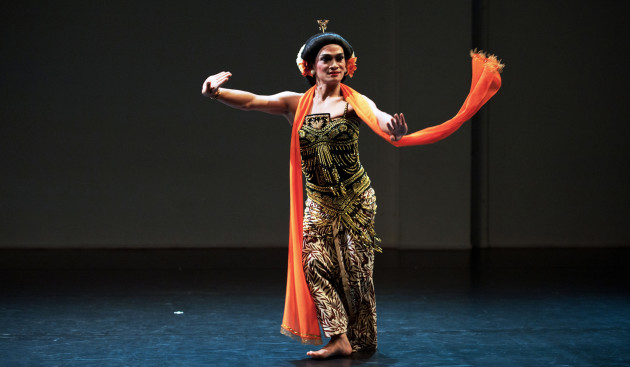OzAsia Festival
Hong Kong’s City Contemporary Dance Company: As If To Nothing
Dunstan Playhouse, Adelaide, 23 September
Choy Ka Faiby featuring Indonesian dancer Rianto: Softmachine: Rinato
Space theatre, Adelaide, 24 September
TerryandTheCuz, Skin
Her Maj Gallery, 1 October
Vertigo Dance Company: Vertigo 20
Dunstan Playhouse, Adelaide, 30 September
The weather wreaked havoc with this year’s OzAsia Festival, forcing the cancellation of some events and the relocation of others. As a result of a state-wide power outage, I was unable to see Split Flow and Holistic Strata by Japanese choreographer Hiroaki Umeda. However, I managed to catch the four other shows on the dance program, which were a somewhat mixed bag. Ironically, the least interesting work was the much-hyped Hong Kong’s City Contemporary Dance Company’s As If To Nothing, choreographed by Sang Jijia. Jijia has worked extensively with William Forsythe, whose influence was very evident in this work, which examines “the impermanence of memories” using dance, a moveable set, video projections and live electronic music. The fourteen dancers gave it their all, but although the staging is intriguing at first, with witty use of projections of the dancers as they emerge in and out of the windows and doors of the mobile set, after twenty minutes the choreography, with its overuse of hyperextensions and armpit lifts, becomes intensely repetitive. At a conceptual level, the work also fails to develop, and at one hour and twenty minutes it truly outlasts its welcome.

Far more intriguing was Softmachine: Rianto, a one-man show by Singaporean director Choy Ka Faiby featuring Indonesian dancer Rianto. A practitioner of the traditional East Javanese cross-gender dance form Lengger, Rianto opens the show in a gorgeous gold-beaded female dress and face mask, executing the dance with grace and delicacy. After stripping off his layered costume to reveal male attire, he performs a combative male dance. Documentary film footage traces Rianto’s journey from rural Indonesia, where he learnt Lengger at the hands of one of its last masters, to downtown Tokyo, where he now studies contemporary dance. The powerful contemporary solo that follows is essentially ungendered, culminating in a gradual reveal of his naked body. The Q and A afterwards featured a stimulating discussion of how gender expectations in contemporary Indonesia are becoming more rigid, in contrast to the relative freedom that has hitherto been a feature of rural life.
Another work with a social message is Skin, by theatre-making duo TerryandTheCuz in collaboration with three Malaysian dancers, Wong Jyh Shyong, Suhaili Micheline Binti Ahmad Kamil and Lee Ren Xin. An exploration of the experience of refugees vulnerable to human trafficking, Skin is an immersive experience in which the audience has to give up all valuables, fill out questionnaires, be interviewed, weighed and subject to various other minor humiliations before being led—half of us blindfolded—to a mystery destination. This turns out to be a shipping container in a nearby vacant block, into which we are packed to sit pressed together uncomfortably to witness a dance performance in an adjacent container fitted up as a meat truck. Rows of performers crawl over the white tiled floor from one end to the other, signifying the endless tide of humanity on the move in search of refuge. The three dancers emerge from this crowd one by one, their razor sharp movements expressing agitation and despair and a desire to stem the tide. This section, however, which is quite abstract, sits oddly with the realist immersion in a refugee’s life with which the piece begins, and the congratulatory section with which it ends. Although Skin has admirable aims, it needs considerable work before its three sections cohere into the powerful work that it could be.
Vertigo 20, on the other hand, by Israel’s Vertigo Dance Company, is a seamless, joyous experience from beginning to end. Constructed as a retrospective of the company’s first twenty years by choreographer Noa Wertheim, the work featured eleven fabulous dancers who are credited as co-creators. Essentially, this work is a celebration of community, which seems fitting as the company lives and works together in an eco-village in rural Israel. With an evocative score by Ran Bagno, a silver-walled set and beautiful lighting credited to Dani-Fishof-Magenta, and a whole lot of balloons, Vertigo 20 reveals a choreographer who has forged her own whimsical and utterly individual language. With a series of solos, duets, trios and ensemble pieces, using big scythe-like upper body movements and springing jumps, Vertigo 20 incorporates folkloric circle dances, animalistic running on all fours, gestural play and inspiring use of canon. The mood shifts from haunting and tender courtship rituals to exhilarating ensemble dances. As a pure celebration of the joy of dance, Vertigo 20 reminded me of Paul Taylor’s Esplanade: the standing ovation it received on opening night is testament to its capacity to transmit that joy to an audience.
In sum, this was a varied and interesting season that certainly rivals recent Adelaide Festival of Arts dance programs.
Maggie Tonkin



